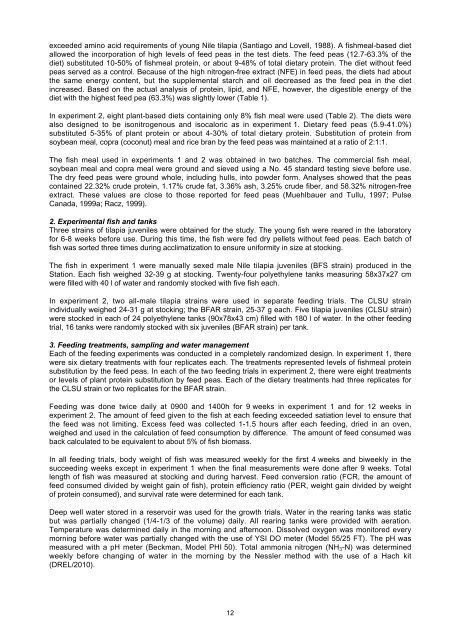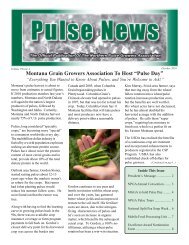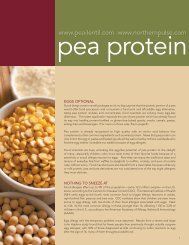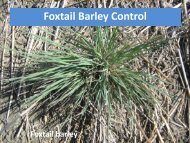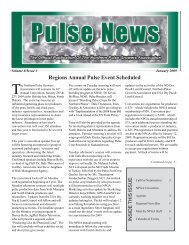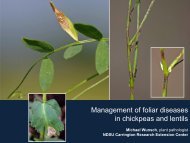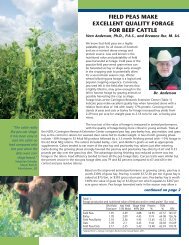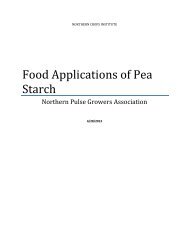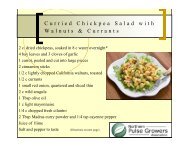<strong>Feed</strong> Pea (Pisum Sativum) As An Alternative Prote<strong>in</strong> SourceIn The Diets Of Nile Tilapia, Oreochromis Niloticus (L.)Corazon B. Santiago, Perla S. Eusebio, <strong>and</strong> Timothy P. WelshAbstractA study was conducted to test feed pea (Pisum sativum) as a prote<strong>in</strong> source <strong>in</strong> Nile <strong>tilapia</strong> <strong>diets</strong> <strong>and</strong> todeterm<strong>in</strong>e its digestibility. In experiment 1, fishmeal-based <strong>diets</strong> were used to allow the maximum level offeed pea as fishmeal prote<strong>in</strong> substitute. Prepared as dry pellets, the test <strong>diets</strong> were isonitrogenous (30%crude prote<strong>in</strong>) <strong>and</strong> approximately isocaloric (14 kJ g -1 ). Fish meal supplied about 28% prote<strong>in</strong> <strong>in</strong> the <strong>diets</strong>.<strong>Feed</strong> peas (12.7-63.3% of the diet) substituted up to 50% of fishmeal prote<strong>in</strong>. The control diet did notconta<strong>in</strong> peas. Manually sexed male Nile <strong>tilapia</strong>, weigh<strong>in</strong>g 32-39 g per fish at stock<strong>in</strong>g, were used. The fishwere reared <strong>in</strong> polyethylene tanks (58x37x27 cm) with aeration. Water was static but was partially changeddaily. Water temperature <strong>for</strong> the whole duration of the experiment ranged from 22-27°C. Fish were allowedto feed to satiation twice daily. The various <strong>in</strong>clusion levels of feed peas did not affect the body weight,feed<strong>in</strong>g activity <strong>and</strong> feed efficiency of the <strong>tilapia</strong>. Weight ga<strong>in</strong> after 9 weeks (range: 21.7+5.6-34.0+9.3 g) didnot differ significantly among treatments (P>0.05). Survival rates were highly variable (40-75%) <strong>and</strong>mortality was not related to treatment. For experiment 2, plant-based <strong>tilapia</strong> <strong>diets</strong> were also designed to beisonitrogenous <strong>and</strong> isocaloric. <strong>Feed</strong> peas <strong>in</strong> the <strong>diets</strong> ranged from 5.9-41.0%. <strong>Feed</strong> peas substituted up to35% of the plant prote<strong>in</strong> (or up to 29% of total dietary prote<strong>in</strong>). Separate feed<strong>in</strong>g trials were conducted ontwo stra<strong>in</strong>s of all-male <strong>tilapia</strong> (CLSU <strong>and</strong> BFAR stra<strong>in</strong>s) us<strong>in</strong>g the same test <strong>diets</strong> <strong>and</strong> larger tanks(90x78x43 cm). Water temperature dur<strong>in</strong>g the two trials ranged from 23-27°C. After 12 weeks of feed<strong>in</strong>g,weight ga<strong>in</strong> did not differ significantly among treatments <strong>in</strong> each <strong>tilapia</strong> stra<strong>in</strong> (45.5+7.8-57.4+12.4 g <strong>for</strong> theCLSU stra<strong>in</strong>; 52.5+4.4-74.1+9.2 g <strong>for</strong> the BFAR stra<strong>in</strong>). FCR <strong>and</strong> PER were not significantly differentamong treatments. Survival was 100% <strong>in</strong> all tanks <strong>in</strong> both trials. Determ<strong>in</strong>ed with the use of chromic oxideas a marker, the apparent prote<strong>in</strong> digestibility of feed pea as <strong>in</strong>gredient was 87.2+2.0%. Diets <strong>in</strong>experiments 1 <strong>and</strong> 2 that conta<strong>in</strong>ed peas had more than 90% prote<strong>in</strong> digestibility. Overall, feed pea is analternative prote<strong>in</strong> source that can be used rout<strong>in</strong>ely <strong>in</strong> the <strong>diets</strong> of Nile <strong>tilapia</strong>.Key words: Tilapia nutrition; <strong>Peas</strong>; Alternative prote<strong>in</strong> source; Fishmeal substitute; DigestibilityIntroductionFish meal is a major source of highly digestible nutrients <strong>and</strong> is a palatable <strong>in</strong>gredient <strong>in</strong> fish <strong>diets</strong>. It can bethe cheapest prote<strong>in</strong> source, at times, based on the price per kilogram of prote<strong>in</strong> (Hardy, 2000). However,the dem<strong>and</strong> <strong>for</strong> fish meal by various food production sectors (e.g., poultry, livestock <strong>and</strong> aquaculture) is<strong>in</strong>creas<strong>in</strong>g while the supply is stagnat<strong>in</strong>g or even decreas<strong>in</strong>g (Starkey, 1994). This causes the ris<strong>in</strong>g cost offish meal. In view of the need to m<strong>in</strong>imize dependence of aquaculture feeds on fish meal, the search <strong>for</strong>alternative prote<strong>in</strong> sources has been an <strong>in</strong>ternational concern.The most commonly used plant prote<strong>in</strong> sources that could partially substitute fish meal <strong>in</strong> fish <strong>diets</strong> are oilseed meals, some leaf meals, <strong>and</strong> cereals <strong>and</strong> their by-products (Gerpacio <strong>and</strong> Castillo, 1979; Zamora <strong>and</strong>Baguio, 1984; Tacon, 1987; NRC, 1993; Hertrampf <strong>and</strong> Piedad-Pascual, 2000). Various feedstuffs,<strong>in</strong>clud<strong>in</strong>g gra<strong>in</strong> legumes, have been tested as fishmeal substitutes <strong>in</strong> farmed <strong>tilapia</strong> (El-Sayed, 1999). Thegra<strong>in</strong> legumes are also called pulses, which refer to edible seeds of plants with pods belong<strong>in</strong>g to the familyLegum<strong>in</strong>ocae (Hertrampf <strong>and</strong> Piedad-Pascual, 2000). Lup<strong>in</strong>s, beans, black <strong>and</strong> green gram, (feed or field)pea <strong>and</strong> several other peas (cow pea, chick pea) belong to this category. Although they are used <strong>in</strong> poultry,sw<strong>in</strong>e, <strong>and</strong> cattle feeds, peas are not among the <strong>in</strong>gredients ord<strong>in</strong>arily added <strong>in</strong> fish <strong>diets</strong>. However, thedigestibility of several species of legume seeds has been studied <strong>in</strong> young <strong>tilapia</strong> (Oreochromis niloticus)(De Silva et al. 1988), juvenile ra<strong>in</strong>bow trout (Oncorhynchus mykiss) (Gomes et al., 1995; Pfeffer et al.,1995; Burel et al., 2000), turbot (Psetta maxima) (Burel et al., 2000), <strong>and</strong> Australian silver perch (Bidyanusbidyanus) (Allan et al., 2000). <strong>Feed</strong> pea (Pisum sativum), <strong>in</strong> particular, has been tested to replace fish meal<strong>in</strong> the <strong>diets</strong> of ra<strong>in</strong>bow trout (Gouveia et al., 1993), European sea bass (Dicentrarchus labrax) (Gouveia <strong>and</strong>Davies, 1998), <strong>and</strong> Atlantic salmon (Salmo salar) (Carter <strong>and</strong> Hauler, 2000). Because of its high potentialas a fish feed <strong>in</strong>gredient, feed pea has to be tested <strong>in</strong> other important food fish, <strong>in</strong>clud<strong>in</strong>g <strong>tilapia</strong>. Thus, thepresent study was conducted to determ<strong>in</strong>e the effect of levels of dietary feed peas on the growth <strong>and</strong>survival of juvenile Nile <strong>tilapia</strong> <strong>and</strong> on feed efficiency. The digestibility of feed peas as an <strong>in</strong>gredient <strong>and</strong> of<strong>diets</strong> conta<strong>in</strong><strong>in</strong>g feed peas was also determ<strong>in</strong>ed.Materials <strong>and</strong> Methods1. Experimental <strong>diets</strong>Two sets of <strong>diets</strong> <strong>in</strong> dry pellet <strong>for</strong>m were tested <strong>in</strong> two separate experiments. For experiment 1, six fishmealbased<strong>diets</strong> (Table 1) were designed to conta<strong>in</strong> 30% crude prote<strong>in</strong> <strong>and</strong> digestible energy of about 14 kJ g -1 .The computed am<strong>in</strong>o acids <strong>in</strong> the <strong>diets</strong>, based on the am<strong>in</strong>o acid contents of the <strong>in</strong>gredients, met or11
exceeded am<strong>in</strong>o acid requirements of young Nile <strong>tilapia</strong> (Santiago <strong>and</strong> Lovell, 1988). A fishmeal-based dietallowed the <strong>in</strong>corporation of high levels of feed peas <strong>in</strong> the test <strong>diets</strong>. The feed peas (12.7-63.3% of thediet) substituted 10-50% of fishmeal prote<strong>in</strong>, or about 9-48% of total dietary prote<strong>in</strong>. The diet without feedpeas served as a control. Because of the high nitrogen-free extract (NFE) <strong>in</strong> feed peas, the <strong>diets</strong> had aboutthe same energy content, but the supplemental starch <strong>and</strong> oil decreased as the feed pea <strong>in</strong> the diet<strong>in</strong>creased. Based on the actual analysis of prote<strong>in</strong>, lipid, <strong>and</strong> NFE, however, the digestible energy of thediet with the highest feed pea (63.3%) was slightly lower (Table 1).In experiment 2, eight plant-based <strong>diets</strong> conta<strong>in</strong><strong>in</strong>g only 8% fish meal were used (Table 2). The <strong>diets</strong> werealso designed to be isonitrogenous <strong>and</strong> isocaloric as <strong>in</strong> experiment 1. Dietary feed peas (5.9-41.0%)substituted 5-35% of plant prote<strong>in</strong> or about 4-30% of total dietary prote<strong>in</strong>. Substitution of prote<strong>in</strong> fromsoybean meal, copra (coconut) meal <strong>and</strong> rice bran by the feed peas was ma<strong>in</strong>ta<strong>in</strong>ed at a ratio of 2:1:1.The fish meal used <strong>in</strong> experiments 1 <strong>and</strong> 2 was obta<strong>in</strong>ed <strong>in</strong> two batches. The commercial fish meal,soybean meal <strong>and</strong> copra meal were ground <strong>and</strong> sieved us<strong>in</strong>g a No. 45 st<strong>and</strong>ard test<strong>in</strong>g sieve be<strong>for</strong>e use.The dry feed peas were ground whole, <strong>in</strong>clud<strong>in</strong>g hulls, <strong>in</strong>to powder <strong>for</strong>m. Analyses showed that the peasconta<strong>in</strong>ed 22.32% crude prote<strong>in</strong>, 1.17% crude fat, 3.36% ash, 3.25% crude fiber, <strong>and</strong> 58.32% nitrogen-freeextract. These values are close to those reported <strong>for</strong> feed peas (Muehlbauer <strong>and</strong> Tullu, 1997; <strong>Pulse</strong>Canada, 1999a; Racz, 1999).2. Experimental fish <strong>and</strong> tanksThree stra<strong>in</strong>s of <strong>tilapia</strong> juveniles were obta<strong>in</strong>ed <strong>for</strong> the study. The young fish were reared <strong>in</strong> the laboratory<strong>for</strong> 6-8 weeks be<strong>for</strong>e use. Dur<strong>in</strong>g this time, the fish were fed dry pellets without feed peas. Each batch offish was sorted three times dur<strong>in</strong>g acclimatization to ensure uni<strong>for</strong>mity <strong>in</strong> size at stock<strong>in</strong>g.The fish <strong>in</strong> experiment 1 were manually sexed male Nile <strong>tilapia</strong> juveniles (BFS stra<strong>in</strong>) produced <strong>in</strong> theStation. Each fish weighed 32-39 g at stock<strong>in</strong>g. Twenty-four polyethylene tanks measur<strong>in</strong>g 58x37x27 cmwere filled with 40 l of water <strong>and</strong> r<strong>and</strong>omly stocked with five fish each.In experiment 2, two all-male <strong>tilapia</strong> stra<strong>in</strong>s were used <strong>in</strong> separate feed<strong>in</strong>g trials. The CLSU stra<strong>in</strong><strong>in</strong>dividually weighed 24-31 g at stock<strong>in</strong>g; the BFAR stra<strong>in</strong>, 25-37 g each. Five <strong>tilapia</strong> juveniles (CLSU stra<strong>in</strong>)were stocked <strong>in</strong> each of 24 polyethylene tanks (90x78x43 cm) filled with 180 l of water. In the other feed<strong>in</strong>gtrial, 16 tanks were r<strong>and</strong>omly stocked with six juveniles (BFAR stra<strong>in</strong>) per tank.3. <strong>Feed</strong><strong>in</strong>g treatments, sampl<strong>in</strong>g <strong>and</strong> water managementEach of the feed<strong>in</strong>g experiments was conducted <strong>in</strong> a completely r<strong>and</strong>omized design. In experiment 1, therewere six dietary treatments with four replicates each. The treatments represented levels of fishmeal prote<strong>in</strong>substitution by the feed peas. In each of the two feed<strong>in</strong>g trials <strong>in</strong> experiment 2, there were eight treatmentsor levels of plant prote<strong>in</strong> substitution by feed peas. Each of the dietary treatments had three replicates <strong>for</strong>the CLSU stra<strong>in</strong> or two replicates <strong>for</strong> the BFAR stra<strong>in</strong>.<strong>Feed</strong><strong>in</strong>g was done twice daily at 0900 <strong>and</strong> 1400h <strong>for</strong> 9 weeks <strong>in</strong> experiment 1 <strong>and</strong> <strong>for</strong> 12 weeks <strong>in</strong>experiment 2. The amount of feed given to the fish at each feed<strong>in</strong>g exceeded satiation level to ensure thatthe feed was not limit<strong>in</strong>g. Excess feed was collected 1-1.5 hours after each feed<strong>in</strong>g, dried <strong>in</strong> an oven,weighed <strong>and</strong> used <strong>in</strong> the calculation of feed consumption by difference. The amount of feed consumed wasback calculated to be equivalent to about 5% of fish biomass.In all feed<strong>in</strong>g trials, body weight of fish was measured weekly <strong>for</strong> the first 4 weeks <strong>and</strong> biweekly <strong>in</strong> thesucceed<strong>in</strong>g weeks except <strong>in</strong> experiment 1 when the f<strong>in</strong>al measurements were done after 9 weeks. Totallength of fish was measured at stock<strong>in</strong>g <strong>and</strong> dur<strong>in</strong>g harvest. <strong>Feed</strong> conversion ratio (FCR, the amount offeed consumed divided by weight ga<strong>in</strong> of fish), prote<strong>in</strong> efficiency ratio (PER, weight ga<strong>in</strong> divided by weightof prote<strong>in</strong> consumed), <strong>and</strong> survival rate were determ<strong>in</strong>ed <strong>for</strong> each tank.Deep well water stored <strong>in</strong> a reservoir was used <strong>for</strong> the growth trials. Water <strong>in</strong> the rear<strong>in</strong>g tanks was staticbut was partially changed (1/4-1/3 of the volume) daily. All rear<strong>in</strong>g tanks were provided with aeration.Temperature was determ<strong>in</strong>ed daily <strong>in</strong> the morn<strong>in</strong>g <strong>and</strong> afternoon. Dissolved oxygen was monitored everymorn<strong>in</strong>g be<strong>for</strong>e water was partially changed with the use of YSI DO meter (Model 55/25 FT). The pH wasmeasured with a pH meter (Beckman, Model PHI 50). Total ammonia nitrogen (NH 3 -N) was determ<strong>in</strong>edweekly be<strong>for</strong>e chang<strong>in</strong>g of water <strong>in</strong> the morn<strong>in</strong>g by the Nessler method with the use of a Hach kit(DREL/2010).12


